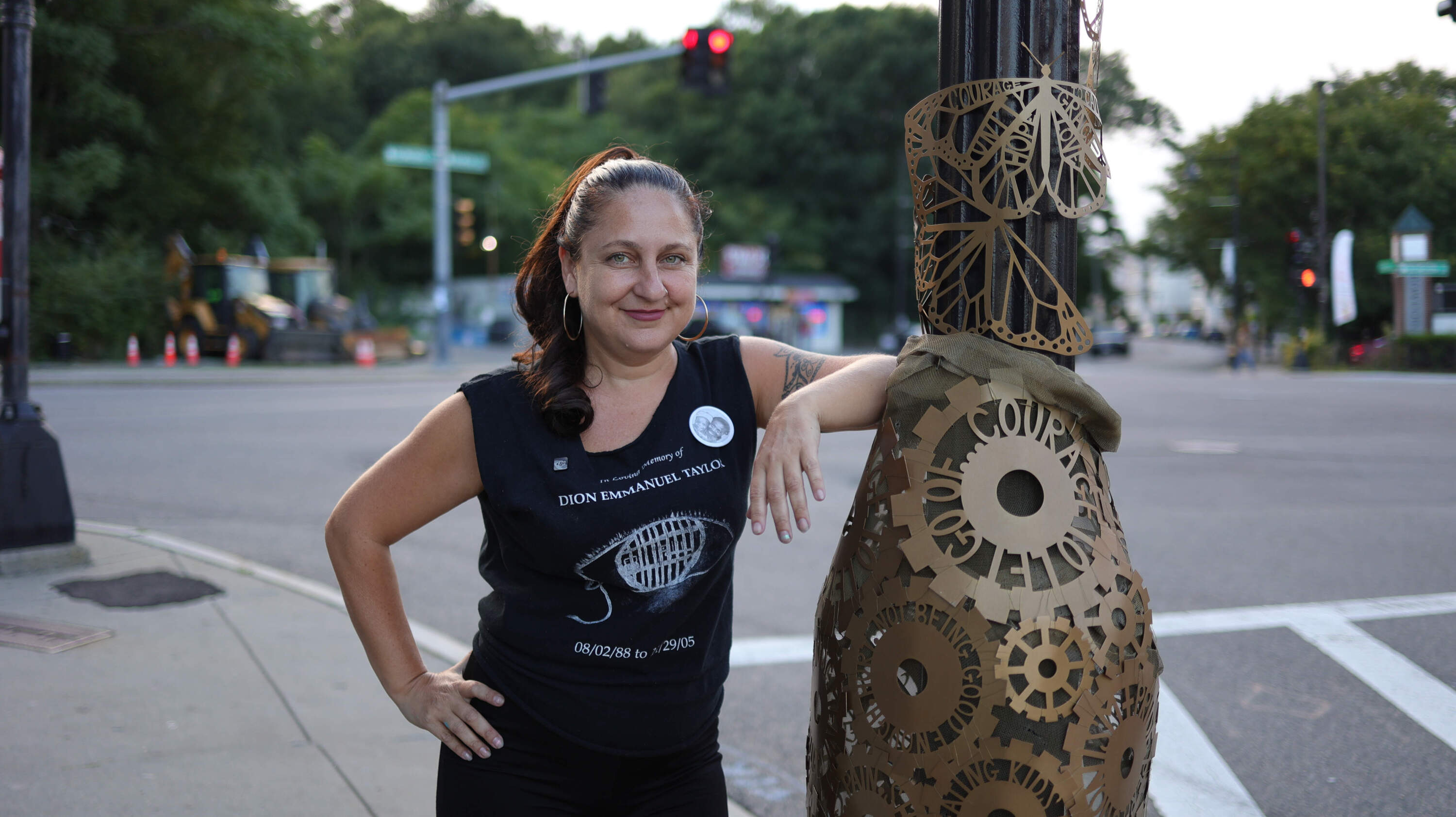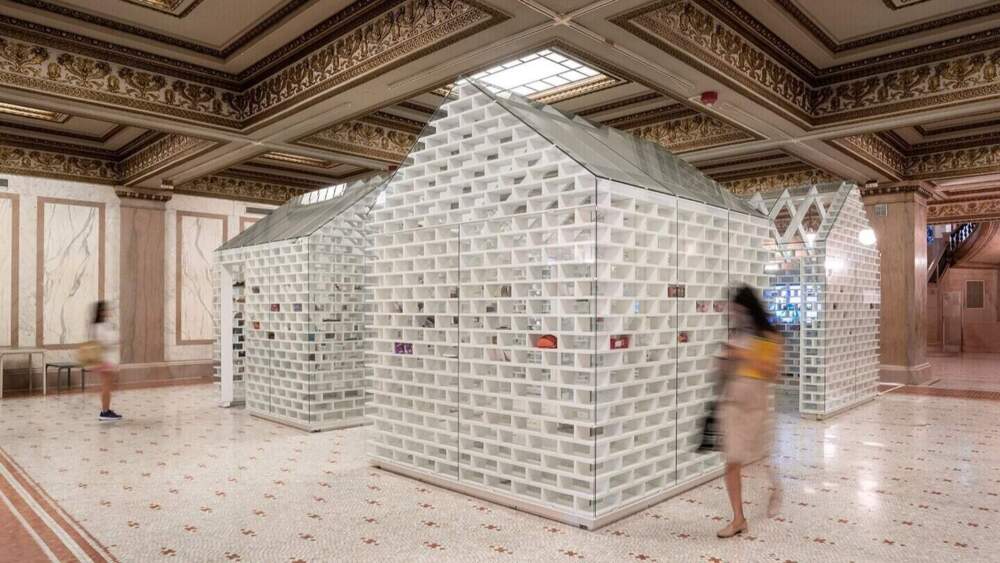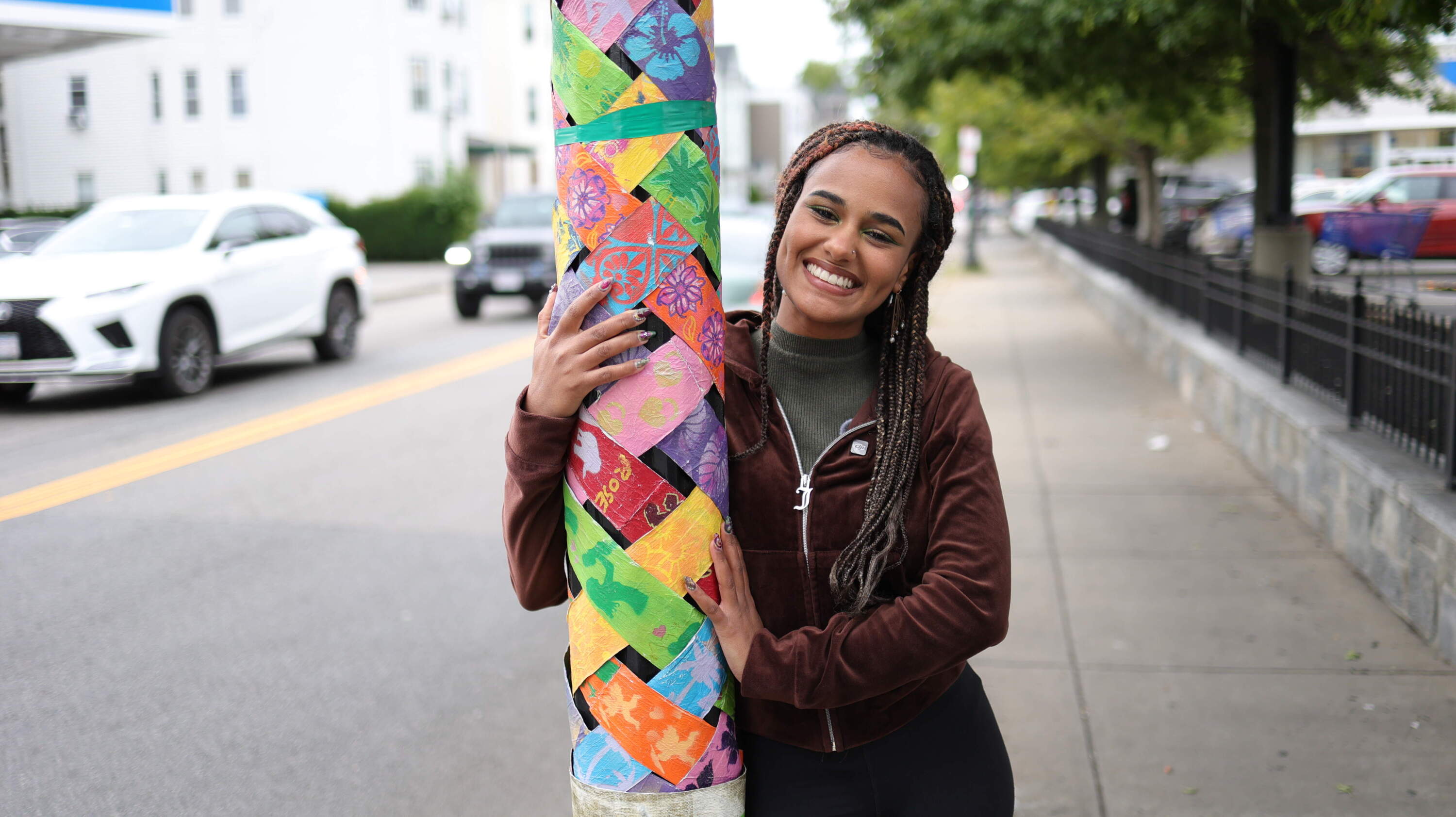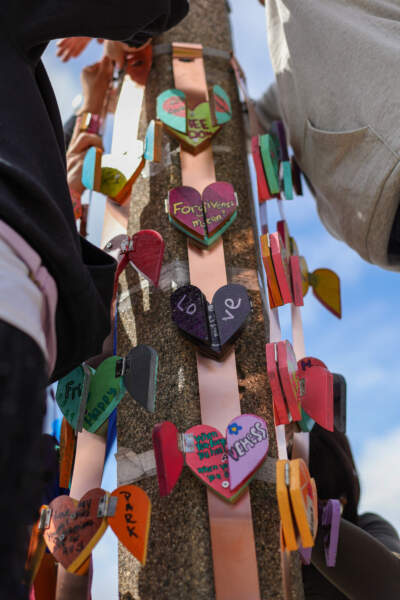Advertisement
In Dorchester, peace trail poles offer connection points for grief survivors

On the corner of Bowdoin Street and Geneva Avenue, a gray concrete pole has been transformed; its purpose goes beyond casting light into dark streets.
At the base of the gray pole, gold mesh is shaped into a kind of chrysalis. Out of this open cocoon emerge thin, aluminum butterflies with a gold patina. The way they’re wired around the pole, they look as if they’re permanently fluttering skyward.
This spot is now a connection point, a place of inspiration, a path of healing across the city like intersecting tree roots. It’s one of seven peace trail poles memorializing lives lost to violence.
Each pole is decorated with mosaics, wood or metal and represents a principle of peace: love, unity, faith, hope, courage, justice and forgiveness. The trail is the brainchild of the Louis D. Brown Peace Institute in Dorchester in collaboration with families who’ve lost loved ones. The Dorchester organization helps survivors of violence navigate loss, find dignity and compassion.

“It’s become a place that I could come to when I needed courage,” said Ruth Henry, artist-in-residence at the Peace Institute. “There's been some moments in my life where I've just needed to come and give it a little hug and get myself a little dose of courage.”
Henry designed the pole with butterflies to focus on the principle of courage. Around the mesh are metal gear shapes with answers people in the community gave to the questions, “What do you want the courage to let go of?” Inside the butterflies are answers given to the question, “What do you want the courage to call in?”
The timing of this public installation coincided with another art exhibit, “The Gun Violence Memorial Project,” which just closed.
Similar in ethos, that project featured four glass houses across the city. Each house features 700 transparent bricks, which act as small compartments to hold memories of a life lost.
Advertisement
The mementoes could be jerseys, keychains, CDs, or stuffed animals. These two installations have been in a kind of conversation for half a year, allowing families touchstones for grief beyond a cemetery. They’ve become places for conversation about loss, violence and where grief mingles with art.
After all, art heals, said Chaplain Clementina Chéry, founder, president and CEO of the Louis D. Brown Peace Institute during a talk at the ICA. They partnered with MASS Design Group to do the sensitive work of collecting objects for the memorial.
“ As painful as it is, the reason why this memorial is here, for me, is it's calling out for peace,” Chéry said. “We need peace for our sake for the sake of the generation that's coming.”

The houses had been on display at the Institute of Contemporary Art, City Hall, and MASS Design Group in the South End for six months. The Peace Trail is adding several more poles in the spring.
In its own way, both the memorial and peace trail poles respond to the question of permanence, how loss, whether due to violence, natural disaster, or pandemic changes a community. There's a need to reckon and process together in a tangible, tactile way.
“ I grew up in Roxbury, Mattapan, Dorchester, and so you always would see these community made memorials on street corners, light poles and there were teddy bears and candles and shoes,” said Jha D Amazi, principal at MASS Design Group and director of the Public Memory and Memorials Lab during at talk at the ICA. “I always asked myself and my mom, how are we going to preserve these? How are we going to protect these? Why do they eventually go away? Why are these not permanent?”

These questions led Henry to ensure the peace trail poles were resilient, that they could withstand the test of time, and be there as a constant reminder for those who need them. Her journey to create the peace trail began with two people, Dion Emmanuel Taylor and his sister, Stacey.
“Dion was an amazing young muralist and photographer and poet, had a contagious smile, just a really charismatic, beautiful young being,” Henry said.

She formed a friendship with his sister, Stacy Ann Taylor after Dion was murdered on Thanksgiving in 2005. They navigated loss together, dreaming up a way to carry Dion’s memory forward. In 2022, Stacy passed abruptly and Henry was left with this seedling of an idea.
"At the forefront of the peace trail poles, is what are the legacies that we want to carry forward in the names of those who have been taken from us,” said Ruth Henry. “Not only holding up and acknowledging loss, but also thinking about what we want to create in their names, the cycles of peace we hope to cultivate.”
There are people in the community, like Nichole Bell, who have a brick in the Gun Violence Memorial exhibit at the ICA and alongside that recently began the process of creating a peace trail pole in her brother Amin T. Bell’s name. She tries to channel him, often.
“ I have a big picture of him on my wall and when I walk past sometimes I talk to him,” she said. “Or sometimes I just look at the picture and smile.”
Bell gathered on one Friday night at the Louis D. Brown Peace Institute with other survivors to write rap lyrics that would be used to decorate a peace trail pole in her brother’s name. Around a table, participants thought up rhymes and beats. They began with a word, passing it around.
“ Healing is rebuilding yourself. Happiness is…”
“Happiness is a field of flowers, waiting for the ocean breeze to rip by you…Courage is…”
“Courage is…standing up for what you believe in. Forgiveness…”
Forgiveness is difficult, Bell admits.
Jamaica Plain resident Lawrence Stevenson began working with homicide survivors at the Peace Institute following his older brother’s death nearly a decade ago. He brought his family to the ICA to see Randy’s brick in The Gun Violence Memorial. It includes a CD of Randy’s own music and photographs.
“The sense of survivorship is so powerful,” he said. “I do not understand how the father, mother, brother, cousin still make their way through the world and create change. To come up in that environment and know this terrible thing happened and know that somehow there is still joy. My brother can’t take my nieces anymore to trick-or-treat, but I can. And there’s meaning in that.”
Turning pain into power and action helped him move through. He always knew he needed to put it somewhere.
“It’s interesting to see him amongst art, for him to be in connection to art,” Stevenson said. “I think there’s a certain celebration about this process that is really special and definitely different then going to see him at the cemetery…I also feel a little bit conflicted because I want the box to be bigger. If he was here, he would be taking up the entire space with his energy.”
